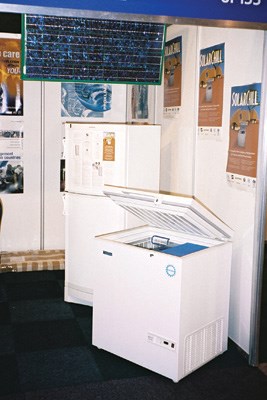Up to three billion people live in regions of the world that lack electricity or a reliable electrical supply. That means vaccines for their children and food too often spoil.
Vancouverite Janos Maté is leading a project to change all that with solarpowered vaccine coolers and refrigerators developed by a consortium led by Greenpeace International.
"It's a wonderful project," Maté said. "It combines environmental health and development issues in a very practical project. It has the potential to bring huge benefits to humanity and shows that we can use 21st-century solar technology to meet basic human needs."
The Global Environment Facility Council based in Washington D.C. approved in November $2.7 million for the SolarChill Project, which involves a long-lasting partnership of seven international organizations including Greenpeace, the United Nations Environment Programme and the World Health Organization.
Three hundred SolarChill appliances will be installed in Kenya, Swaziland and Colombia over the next three years.
"Our intention is eventually to ensure that every part of the world where there's no electricity has access to these units," said Maté, a Greenpeace activist.
Greenpeace first entered into refrigeration in the early 1990s when it opposed the use of ozonedestroying fluorocarbons. When companies that produced fluorocarbons attacked Greenpeace for criticizing and not providing solutions, Greenpeace Germany, with the help of scientists and engineers, developed a prototype for a more environmentally friendly refrigeration technology that uses hydrocarbons. Despite significant obstructions, this GreenFreeze technology now makes up 40 per cent of refrigerator production worldwide.
Maté and a UN colleague attended a UN conference in Burkina Faso in 1999, noticed refrigerators on sidewalks of the capital city and conceived the idea of powering them with solar energy, rather than kerosene, propane and lead batteries.
Their agencies alongside others, including the Danish Technological Institute, developed the SolarChill technology. SolarChill units use solar power from two or three 60-or 80-watt solar panels that run a direct current compressor. The compressor helps produce an ice bank that maintains the required temperature.
Vaccines need to be stored between two and eight degrees centigrade and millions of dollars worth of vaccines are spoiled each year without proper refrigeration.
SolarChill coolers cost $500 to $2,000 more to buy than kerosene and gas coolers due to the high cost of solar panels. But
Greenpeace International reports that over a 20-year period, SolarChill units would save up to $6,000 in overall costs because of fuel savings. Greenpeace reports the cost of solar panels has declined in the past two years.
Factories in Denmark, Swaziland, China and the U.K. produce SolarChill products. SolarChill Project partners hold no commercial interest in the technology but hope to see it adopted by manufacturers, especially those in developing countries, worldwide.
Fridges and coolers have been field-tested in Indonesia, Senegal, Cuba and India. Vaccine coolers were sent to Haiti after the 2010 earthquake and are used in refugee camps in Sudan.
Maté expects a SolarChill refrigerator to be field-tested at the University of B.C. Farm within three months.
[email protected] Twitter: @Cheryl_Rossi



